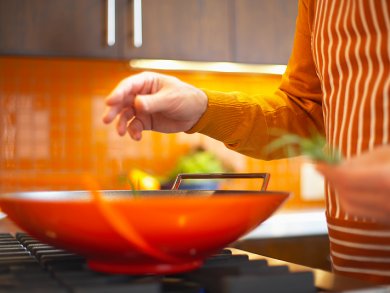Hiroshi Shinokubo is Professor at the Department of Engineering, Nagoya University, Japan. His research interests include organic synthesis, organometallic chemistry, porphyrin related molecules, and functional materials. If Hiroshi Shinokubo was not an organic chemist, he probably would be a chef in a restaurant specialized in Ramen – a Japanese noodle soup. But here he shares another recipe with us: Buta-no-Kakuni – Sweet and Tender Stewed Pork.
In the Lab
 What was your first experiment?
What was your first experiment?
It was the determination of the concentration of butyllithium in hexane to prepare lithium diisopropylamide.
When was the last time you did an experiment in the lab – and what was it?
It was a Kumada coupling reaction to synthesize terthiophene four years ago. I was preparing the simplified reaction procedure for an undergraduate experimental class.
What is the most exciting experiment you did?
It was the synthesis of porphyrin analogues in water. I got so many products in beautiful different colors. However, I had to separate the products with very tedious chromatography that took all day long.
What was your biggest experimental mishap?
Fortunately, I myself haven’t had a big mishap. However, the LiAlH4 reduction by a lab mate caught fire one day. That was a dangerous situation but the fire was beautiful like a firework. However, I don’t want to see such a scene again.
What advice would you give up-and-coming scientists?
I am not yet experienced enough to give advice to other scientists. Impressive advice I was given by my mentor is if you come up with an idea, you should try it immediately before checking the literature.
On the Stove

Please share your favorite recipe with us.
See below.
Please give some personal remarks why you chose this one.
In our research group we have a party at my house twice a year. Every time I cook this dish by myself and serve it for the students.
If you were having a dinner party and could invite somebody, past or present, who would that be – and why?
Robert Burns Woodward and Albert Einstein. I would like to ask them what their research targets would be if they were living in our present times.
Would you like to give some advice on cooking?
If you want to cook well, you should eat good food often and analyze it carefully with your own testing instrument, your tongue.
Hiroshi Shinokubo´s Recipe
Buta-no-Kakuni – Sweet and Tender Stewed Pork

Boil a joint of pork belly for 30 min in hot water and cut the pork into slices 1.5 cm thick.
Simmer the pork in water and Japanese sake for about 1 hour. After cooling to room temperature, leave it overnight in a cool place, such as the refrigerator, until the oil layer from the pork becomes white and hard. Remove the oil layer to reduce fat. Also, if you skip this step, you won’t have a good flavor. Then add soy sauce, mirin, and sugar. The pork is then stewed for about 3 hours on a low heat until the pork becomes very soft.
 Hiroshi Shinokubo was born in Kyoto, Japan, in 1969 and he graduated from Kyoto University in 1992. He obtained his doctorate there in 1998. He was appointed as Assistant Professor at the Department of Engineering, Kyoto University, in 1995. Shinokubo worked with Professor Rick L. Danheiser at the Massachusetts Institute of Technology (MIT), Cambridge, USA, from 1999 to 2000 as a visiting scientist. He then moved to the Department of Chemistry, Graduate School of Science, Kyoto University as Associate Professor in 2003. In 2008, he became Professor at the Department of Engineering, Nagoya University.
Hiroshi Shinokubo was born in Kyoto, Japan, in 1969 and he graduated from Kyoto University in 1992. He obtained his doctorate there in 1998. He was appointed as Assistant Professor at the Department of Engineering, Kyoto University, in 1995. Shinokubo worked with Professor Rick L. Danheiser at the Massachusetts Institute of Technology (MIT), Cambridge, USA, from 1999 to 2000 as a visiting scientist. He then moved to the Department of Chemistry, Graduate School of Science, Kyoto University as Associate Professor in 2003. In 2008, he became Professor at the Department of Engineering, Nagoya University.
His research interests include organic synthesis, organometallic chemistry, porphyrin related molecules, and functional materials.
Selected Awards
- Japan Society for the Promotion of Science (JSPS)-Prize (2012)
- The Commendation for Science and Technology by the Ministry of Education, Culture, Sports, Science and Technology (MEXT), The Young Scientists’ Prize (2009)
- Banyu Young Chemist Award (2008)
Selected Publications
- Synthesis of Highly Distorted pi-Extended [2.2] Metacyclophanes by Intermolecular Double Oxidative Coupling,
Y. Koyama, S. Hiroto, H. Shinokubo,
Angew. Chem. Int. Ed. 2013.
DOI: 10.1002/anie.201301180 - Gram-Scale Synthesis of Nickel(II) Norcorrole: The Smallest Antiaromatic Porphyrinoid,
T. Ito, Y. Hayashi, S. Shimizu, J.-Y. Shin, N. Kobayashi, H. Shinokubo,
Angew. Chem. Int. Ed. 2012, 51 (34), 8542–8545.
DOI: 10.1002/anie.201204395 - Metal-Mediated Synthesis of Antiaromatic Porphyrinoids from a BODIPY Precursor,
T. Sakida, S. Yamaguchi, H. Shinokubo, 50 (10), 2280–2283.
Angew. Chem. Int. Ed. 2011, 50 (10), 2280–2283.
DOI: 10.1002/anie.201006314 - Synthesis and Biradicaloid Character of Doubly Linked Corrole Dimers,
S. Hiroto, K. Furukawa, H. Shinokubo, A. Osuka,
J. Am. Chem. Soc. 2006, 128 (38), 12380–12381.
DOI: 10.1021/ja062654z
- Author Profile: Hiroshi Shinokubo
Angew. Chem. Int. Ed. 2013.
DOI: 10.1002/anie.201207020 - See all Cooking in Chemistry interviews
 The idea to show what top scientists like to cook – on the bench and on the stove – is taken from the very successful book:
The idea to show what top scientists like to cook – on the bench and on the stove – is taken from the very successful book:
What’s Cooking in Chemistry: How Leading Chemists Succeed in the Kitchen
H. P. Bell, T. Feuerstein, C. E. Güntner, S. Hölsken, J. K. Lohmann,
Wiley-VCH, Weinheim, Germany, 2009.
ISBN: 978-3-527-32621-1


